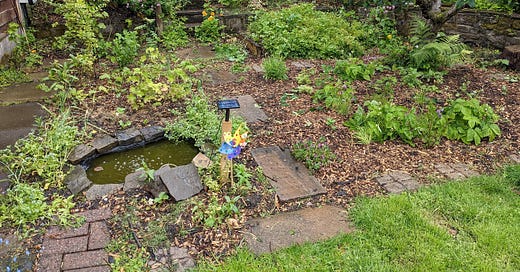This is the start of an ongoing series of how I became enamored with agroforestry and perennial vegetables.
If you like what you’re reading and want to support my continued writing, please consider subscribing so these posts will arrive straight to your inbox. If you’re feeling generous, there are also paid subscription options - this will encourage me to write more, better and deeper content!
Turn time back to the first pandemic lock down in the UK (Spring 2020). My wife and I found ourselves facing full time work and full time childcare duties, and something had to give. Along with many Britons in the same place, it was the garden that gave, but in an most unexpected way.
I was used to rushing around: wake up, daughter to school, commute to the city centre for work, commute back just in time to pick the daughter up, hastily cook dinner, daughter to bed, self to bed, rinse, repeat and collapse at the weekend. Now I had an unknown length of time at home and I turned to my garden for some much needed therapy.
My garden was a typical barely maintained one: every few weeks, mow the lawn and ignore until it became to straggly. So the first thing I did was mow the lawn more often - great, now we have a rubbish approximation of a bowling green. Then I became more ambitious and set my sights on expanding the patio. This complete, I laser focused on the shady north facing ornamental border.
The First Lesson
Now before I continue, for readers unaccustomed to your typical British garden, they’re usually small - ten by ten metres-ish - and they’re usually adjacent to other gardens with wooden fences. This means that there a lot micro-climates in a small space. My garden backs onto my house and has fences on both sides. One north facing and basically permanently shaded, and one very sunny south facing fence. In practical terms, the shadowy north side is the perfect moss environment and created an ugly - or so I foolishly thought at the time - carpet on all the soil around the ornamental plants. So I grabbed a hoe and scraped all that moss away and threw it in the bin. I actually cringe at that recollection. Later on, the moss happily grew back, willing to forgive, and I beat it back into submission. In exasperation I reached out to some online gardening communities and instead of the expected weedkiller advice, I was told that if the moss liked it so much, it was meant to be there, like a duck to water! Further more, I was told that raking up the topsoil like that would create a burst of life (which I indeed saw) but then lead to rapid soil deterioration! These things made little sense to me as I was used to bending my garden to my will by this time.
I wanted my duck on a silver platter, but this journey I unwittingly began would lead me to more robust, unusual vegetables, edible forests and looking after soil like a plant…




